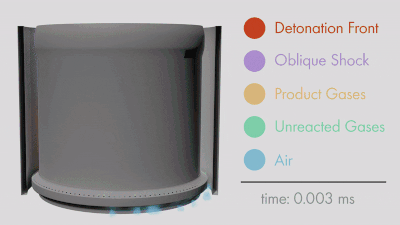
Posted on 08/22/2021 5:28:49 PM PDT by BenLurkin
The Japan Aerospace Exploration Agency (JAXA) has announced that it has successfully demonstrated the operation of a “rotating detonation engine” for the first time in space. The novelty of the technologies in question is that such systems obtain a large amount of thrust by using much less fuel compared to conventional rocket engines, which is quite advantageous for space exploration.
On July 27, the Japanese agency launched a pair of futuristic propulsion systems into space to carry out the first tests. They were launched from the Uchinoura Space Center aboard the S-520-31, a single-stage rocket capable of lofting a 220 lbs (100 kg) payload well above 186 miles (300 km). After recovering the rocket from the ocean, the JAXA team of engineers analyzed the data and confirmed the success of the mission, which put the new system at an estimated altitude of (146 miles) 234.9 km.
The rotating detonation engine uses a series of controlled explosions that travel around an annular channel in a continuous loop. This process generates a large amount of super-efficient thrust coming from a much smaller engine using significantly less fuel – which also means sending less weight on a space launch. According to JAXA, it has the potential to be a game-changer for deep space exploration.
(Excerpt) Read more at inceptivemind.com ...

flr
God was a knocking and he wanted in real bad.😏
So basically it is a pulse jet with organized timing and spin to it?
I wonder if that internal spin applies any torque to the whole assembly? Probably very minimal in any?
Jerry Pournelle and Larry Niven had a book in which small nuclear bombs were exploded beneath the rocket to get to space.
Yeah, the book was called “Footfall”.
But this sounds more complex.
Kinda like a continuous spiral detonation (pulse) jet where the detonation wave(s) remain(s) in a plane. As if sitting on those torches wasn’t enough now they are going to be a constant explosion as propulsion.
No.
I think that was Footfall.
There were some of the “old” ships in the reboot of Battle Star galactica that had this as a sunlight propulsion. They didn’t say anything but some of the craft had a huge cluster of nozzles in the back with timed explosions instead of a continuous stream.
I love when shows at least make an effort toward hard science.
Sub light.
Stupid phone
The math required to do this work must be otherworldly.
Beat me to it!
...a Wankel rocket?
I remember those ads!
Yup.
No. The only thing similar is the name.
Briefly an explosion is a much more efficient release of energy than a continuous stream of fire going out the back of a rocket motor.
The problem is the release of energy is all at once.
So you need to either make it small and balance it with a bunch of little explosions or have some sort of shock absorber. Or both.
Think of a giant spaceship with 100 nozzles in the back in a big round cluster.
They’re all off. The captain says “go” and one single nozzle lights up for just a second. The another lights up for a second on the opposite side.
Boom. Boom.boom. You can see each one. On off. On off. Slow.
Then the pattern starts speeding up and eventually it looks like all the nozzles are lit up at the same time. They’re not. It’s just the pattern of explosions is going fast enough that it looks like they are all on.
It’s probably how we will go between stars.
Wonder how long it will burn before melting into slag. Got to admit though, the controlled wave spin is a cool effect.
More work extracted from the same propellant implies it will run cooler. Energy can neither be created not destroyed in the Newtonian realm. More work extracted means less waste heat.
In practice, I don’t know, but the physics predict this.
You are correct that the thrust-to-waste-heat ratio is higher.
But the engine runs hotter because more is actually burned.
Disclaimer: Opinions posted on Free Republic are those of the individual posters and do not necessarily represent the opinion of Free Republic or its management. All materials posted herein are protected by copyright law and the exemption for fair use of copyrighted works.